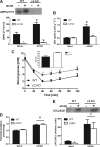Whole body deletion of AMP-activated protein kinase {beta}2 reduces muscle AMPK activity and exercise capacity
- PMID: 20855892
- PMCID: PMC2988326
- DOI: 10.1074/jbc.M110.102434
Whole body deletion of AMP-activated protein kinase {beta}2 reduces muscle AMPK activity and exercise capacity
Abstract
AMP-activated protein kinase (AMPK) β subunits (β1 and β2) provide scaffolds for binding α and γ subunits and contain a carbohydrate-binding module important for regulating enzyme activity. We generated C57Bl/6 mice with germline deletion of AMPK β2 (β2 KO) and examined AMPK expression and activity, exercise capacity, metabolic control during muscle contractions, aminoimidazole carboxamide ribonucleotide (AICAR) sensitivity, and susceptibility to obesity-induced insulin resistance. We find that β2 KO mice are viable and breed normally. β2 KO mice had a reduction in skeletal muscle AMPK α1 and α2 expression despite up-regulation of the β1 isoform. Heart AMPK α2 expression was also reduced but this did not affect resting AMPK α1 or α2 activities. AMPK α1 and α2 activities were not changed in liver, fat, or hypothalamus. AICAR-stimulated glucose uptake but not fatty acid oxidation was impaired in β2 KO mice. During treadmill running β2 KO mice had reduced maximal and endurance exercise capacity, which was associated with lower muscle and heart AMPK activity and reduced levels of muscle and liver glycogen. Reductions in exercise capacity of β2 KO mice were not due to lower muscle mitochondrial content or defects in contraction-stimulated glucose uptake or fatty acid oxidation. When challenged with a high-fat diet β2 KO mice gained more weight and were more susceptible to the development of hyperinsulinemia and glucose intolerance. In summary these data show that deletion of AMPK β2 reduces AMPK activity in skeletal muscle resulting in impaired exercise capacity and the worsening of diet-induced obesity and glucose intolerance.
Figures







Similar articles
-
AMP-activated protein kinase (AMPK) beta1beta2 muscle null mice reveal an essential role for AMPK in maintaining mitochondrial content and glucose uptake during exercise.Proc Natl Acad Sci U S A. 2011 Sep 20;108(38):16092-7. doi: 10.1073/pnas.1105062108. Epub 2011 Sep 6. Proc Natl Acad Sci U S A. 2011. PMID: 21896769 Free PMC article.
-
Effects of alpha-AMPK knockout on exercise-induced gene activation in mouse skeletal muscle.FASEB J. 2005 Jul;19(9):1146-8. doi: 10.1096/fj.04-3144fje. Epub 2005 May 5. FASEB J. 2005. PMID: 15878932
-
Knockout of the alpha2 but not alpha1 5'-AMP-activated protein kinase isoform abolishes 5-aminoimidazole-4-carboxamide-1-beta-4-ribofuranosidebut not contraction-induced glucose uptake in skeletal muscle.J Biol Chem. 2004 Jan 9;279(2):1070-9. doi: 10.1074/jbc.M306205200. Epub 2003 Oct 21. J Biol Chem. 2004. PMID: 14573616
-
LKB1 and AMPK and the regulation of skeletal muscle metabolism.Curr Opin Clin Nutr Metab Care. 2008 May;11(3):227-32. doi: 10.1097/MCO.0b013e3282fb7b76. Curr Opin Clin Nutr Metab Care. 2008. PMID: 18403917 Free PMC article. Review.
-
AMPK regulation of fatty acid metabolism and mitochondrial biogenesis: implications for obesity.Mol Cell Endocrinol. 2013 Feb 25;366(2):135-51. doi: 10.1016/j.mce.2012.06.019. Epub 2012 Jun 28. Mol Cell Endocrinol. 2013. PMID: 22750049 Review.
Cited by
-
Interactive Roles for AMPK and Glycogen from Cellular Energy Sensing to Exercise Metabolism.Int J Mol Sci. 2018 Oct 26;19(11):3344. doi: 10.3390/ijms19113344. Int J Mol Sci. 2018. PMID: 30373152 Free PMC article. Review.
-
The IL-6 Paradox: Context Dependent Interplay of SOCS3 and AMPK.J Diabetes Metab. 2013 May 24;Suppl 13:10.4172/2155-6156.S13-003. doi: 10.4172/2155-6156.S13-003. J Diabetes Metab. 2013. PMID: 24244888 Free PMC article.
-
Targeted therapies of the LKB1/AMPK pathway for the treatment of insulin resistance.Future Med Chem. 2010 Dec;2(12):1785-96. doi: 10.4155/fmc.10.264. Future Med Chem. 2010. PMID: 21428801 Free PMC article. Review.
-
Hypoxia Induces Changes in AMP-Activated Protein Kinase Activity and Energy Metabolism in Muscle Tissue of the Oriental River Prawn Macrobrachium nipponense.Front Physiol. 2018 Jun 14;9:751. doi: 10.3389/fphys.2018.00751. eCollection 2018. Front Physiol. 2018. PMID: 29962970 Free PMC article.
-
AMP-Activated Protein Kinase (AMPK) and Energy-Sensing in the Brain.Exp Neurobiol. 2012 Jun;21(2):52-60. doi: 10.5607/en.2012.21.2.52. Epub 2012 Jun 12. Exp Neurobiol. 2012. PMID: 22792025 Free PMC article.
References
Publication types
MeSH terms
Substances
LinkOut - more resources
Full Text Sources
Other Literature Sources
Molecular Biology Databases
Research Materials

